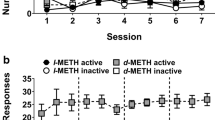Abstract
Differences in tolerance and cross-tolerance to the behavioral effects of d-amphetamine sulfate and mescaline hydrochloride were studied as a function of intraventricular or intraperitoneal routes of administration. Operant behavior, using a fixed ratio schedule of food reinforcement, was the behavioral variable. Following tolerance to d-amphetamine infused intraventricularly, an approximately equipotent dose of mescaline, similarly administered the next day, resulted in behavioral disruption indicating a lack of cross-tolerance. However, following tolerance to mescaline administered intraventricularly, an equipotent dose of d-amphetamine infused the next day did not result in behavioral disruption, indicating cross-tolerance, When d-amphetamine (1.6 or 2.5 mg/kg) and mescaline (10 mg/kg) were administered peripherally (i.p.), no cross-tolerance was found, regardless of the order of drug presentation. Finally, tolerance to amphetamine administered intraventricularly was not indicative of tolerance to amphetamine given intraperitoneally. The next day (after central tolerance) amphetamine disrupted the operant to an equal or greater extent than it had prior to central tolerance formation. This is further evidence that drugs administered directly into the CNS may not be producing their behavioral effects in the same manner as they do via peripheral administration.
Similar content being viewed by others
References
Aghajanian, G. K.: The effect of LSD on raphé nuclei neurons. Neurosciences Res. Progr. Bull. 8, 40–48 (1970).
—, Foote, W. E., Sheard, M. H.: Action of psychotogenic drugs on single midbrain raphé neurons. J. Pharmacol. exp. Ther. 171, 178–187 (1970).
Appel, J. B., Freedman, D. X.: Tolerance and cross-tolerance among psychotomimetic drugs. Psychopharmacologia (Berl.) 13, 267–274 (1968).
Borison, H. L., McCarthy, L. E., Clark, W. G., Radhakrishnan, N.: Vomiting, hyperthermia and respiratory paralysis due to tetrodotoxin (puffer fish poison) in the cat. Toxicol. appl. Pharmacol. 5, 350–357 (1963).
Feldberg, W., Fleischhauer, K.: A new experimental approach to the physiology and pharmacology of the brain. Brit. med. Bull. 21, 36–43 (1965).
Feldberg, W., Sherwood, S. L.: Injections of drugs into the lateral ventricle of the cat. J. Physiol. (Lond.) 123, 148–167 (1954).
— —: Injections of bulbocapnine into the cerebral ventricles of cats. Brit. J. Pharmacol. 10, 371–374 (1955).
Foote, W. E., Sheard, M. H., Aghajanian, G. K.: Comparison of effects of LSD and amphetamine on midbrain raphé units. Nature (Lond.) 222, 567–569 (1969).
Herman, Z. S.: The effects of noradrenaline on rats' behaviour. Psychopharmacologia (Berl.) 16, 369–374 (1970).
Isbell, H., Wolbach, A., Wiler, A., Miner, E.: Cross-tolerance between LSD and psilocybin. Psychopharmacologia (Berl.) 2, 147–159 (1961).
Rech, R. H.: The relevance of experiments involving injection of drugs into the brain. In: Importance of fundamental principles in drug evaluation, pp. 325 to 360. D. H. Tedeschi and R. R. Tedeschi (eds.). New York: Raven Press 1968.
Robinson, R., Cutler, W., Lorenzo, A., Barlow, C.: Transport of sulfate, thiosulfate and iodide by choroid plexus in vitro. J. Neurochem. 15, 1169–1179 (1968).
Rosenberg, D. E., Wolbach, A. B., Miner, E. J., Isbell, H.: Observations on direct and cross-tolerance with LSD and d-amphetamine in man. Psychopharmacologia (Berl.) 5, 1–15 (1963).
Rothballer, A. B.: Effects of catecholamines on the central nervous system. Pharmacol. Rev. 11, 494–547 (1959).
Schain, R. J.: Actions of pharmacologically active substances in cerebrospinal fluid upon the central nervous system. Wld Neurol. 3, 706–715 (1962).
Tilson, H. A., Sparber, S. B.: Differences in tolerance to mescaline produced by peripheral and direct central administration. Psychopharmacologia (Berl.) 19, 313–323 (1971).
Winterstein, H.: The actions of substances introduced into the cerebrospinal fluid and the problem of intracranial chemoreceptors. Pharmacol. Rev. 13, 71–107 (1961).
Winters, W. D.: Neuropharmacological studies utilizing evoked response techniques in animals. In: Psychopharmacology: A review of progress 1957–1967, D. H. Efron, ed. Washington: U.S. Government Printing Office 1968.
Wolbach, A., Isbell, H., Miner, E.: Cross-tolerance between mescaline and LSD-25 with a comparison of the mescaline and LSD reactions. Psychopharmacologia (Berl.) 3, 1–14 (1962).
Author information
Authors and Affiliations
Additional information
Supported in part by Grant MH-08565 from USPHS. H.A.T. is a predoctoral fellow in the Department of Psychology, University of Minnesota.
Rights and permissions
About this article
Cite this article
Sparber, S.B., Tilson, H.A. Tolerance and cross-tolerance to mescaline and amphetamine as a function of central and peripheral administration. Psychopharmacologia 23, 220–230 (1972). https://doi.org/10.1007/BF00404128
Received:
Revised:
Issue Date:
DOI: https://doi.org/10.1007/BF00404128




